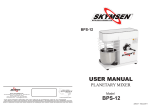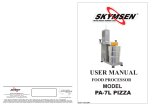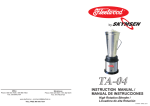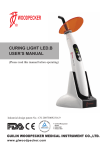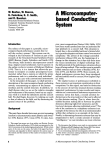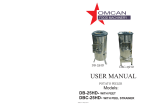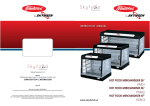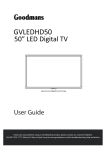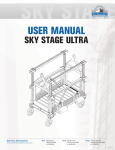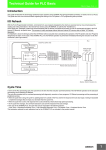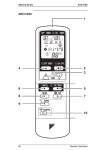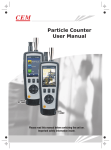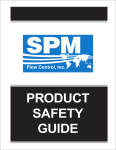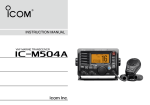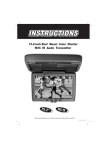Download INSTRUCTION MANUAL - Metalúrgica Siemsen
Transcript
METALÚRGICA SIEMSEN LTDA. INSTRUCTION MANUAL METALÚRGICA SIEMSEN LTDA. METAL RGICA SIEMSEN LTDA. Rua Anita Garibaldi, nº 262 – Bairro: Sn o Luiz – CEP: 88351-410 Brusque – Santa Catarina – Brasil Fone: +55 47 3255 2000 – Fax: +55 47 3255 2020 www.siemsen.com.br - [email protected] LINHA DIRETA SKYMSEN Ramais 2011 Bone Saw Models 2012 2013 SKG and SKLG E-mail: [email protected] - ALÉM DESTAS MÁQUINAS, FABRICAMOS UMA LINHA COMPLETA DE EQUIPAMENTOS. CONSULTE SEU REVENDEDOR. - ESTE PRODUTO CONTA COM ASSISTÊNCIA TÉCNICA, REPRESENTANTES E REVENDEDORES EM TODO TERRITÓRIO NACIONAL. DEVIDO À CONSTANTE EVOLUÇÃO DOS NOSSOS PRODUTOS, AS INFORMAÇÕES AQUI CONTIDAS PODEM SER MODIFICADAS SEM AVISO PRÉVIO. 22827.3 - Março/2011 SUMMARY 1. INTRODUCTION 02 1.1 Safety 1.2 Main Components 1.3 Technical Characteristics 02 02 04 2. INSTALLATION and PRE OPERATION 04 2.1 Installation 2.2 Pre Operation 04 05 3. OPERATION 05 3.1 Operation Process 3.2 Cleaning 05 05 4. GENERAL SAFETY RULES 07 4.1 4.2 4.3 4.4 4.5 4.6 4.7 08 09 09 10 10 10 10 Operation Fundamentals Practices Cares and Observations before to Switch On the Saw Routine Inspection Operation After the Work Ends Maintenance Performance Notices 5. PROBLEMS ANALYSIS and SOLUTIONS 11 5.1 Problems , Causes and Solutions 5.2 Adjustement and Components Substitution 5.3 Electrical Diagram Models SKG and SKLG 11 11 14 01 1. INTRODUCTION 1.1 Safety If and when the Bone Saws Mod. SKG and SKLG , are not correctly used , they are potentially DANGEROUS machines . Cleaning and any other maintenance service shall be carried out by duly trained people , and with the plug off its socket . To avoid ACCIDENTS follow the instructions below : 1.1.1Take the electric plug off its socket , before to withdraw any moving part , before cleaning or any other maintenance operation . 1.1.2Never use any kind of tools , not belonging to the saw to help cutting . 1.1.3Never touch the saw blade No 07 ( Pct.01) , even with the saw switched off , because the blade has sharp edges . 1.1.4Never adjust the blade guide No.06 (Pct.01) , nor the cut regulator No.14(Pct.01) with the saw blade in movement . 1.1.5Never use water sprays directly on the saw . 1.1.6During cutting operation , never use loose clothes with wide sleeves principally around the wrists . 1.1.7Use steel gloves during cutting operation . 1.1.8Keep hands away from moving parts . 1.1.9Never switch on the saw with any of its doors open No.03 or No. 16(Pct.01) . 1.2 Main Components All components are manufactured with carefully chosen raw materials in accordance with Siemsen experience and testing standards . 02 Unusual noises Blade slipping on wheels Turn the blade tension regulator.See item 5. 2. 2 Picture - 01 01 The blade frequently tears Difficulty to cut the meat The blade is not correctly welded Change the blade The blade or the wheels are dirty Clean the saw . See item 3. 2 Faulty wheels Change the wheels The blade or the wheels are dirty 10 03 02 19 04 05 12 Clean the saw . See item 3. 2 06 13 Wrong tension on the blade . Regulate the blade tension. See item 5. 2. 2 07 18 The blade is off the wheels center Proceed to adjust the upper bearing. See item 5. 2. 5 . When no improvement is obtained call Skynsen Technical Assistance . 08 14 15 16 09 04 10 5.3 ELECTRIC DIAGRAM . MOD. SKG AND SKLG 11 17 ON/Off Switch M Voltage Selecting Switch 14 1.Blade Tension Regulator 2.On/off Switch with Plastic Protection 3.Upper Front Door 4.400 mm Wheel 5.M8x30 mm Handle 6.Blade Guide 7.Blade ( Width 5/8”) 8.Movable Table 9.110/220 Volts Selecting Switch 10.Staple 11.Rack 12.Frame 13.M8x30 mm Handle 14.Cut Regulator ( Cut thickness Regulator) 15.Fixed Table 16.Lower Front Door 17.Trash Box 18.Spherical Handle 19.Upper Door Handle 03 1.3 Technical Characteristics Table - 02 Table - 01 Characteristics Average Production Voltage Frequency Power Rating Consumption Height Width Depth Net Weight Gross Weight Maximun Cutting Width Maximun Cutting Height Unit kg/h V Hz Hp kW/h mm mm mm kg kg mm mm SKG (Painted) SKLG(Stainless) up to 1000 up to 1000 110 / 220 110 / 220 50 or 60 (*) 50 or 60 (*) 1,5 1,5 1,1 1,1 1850 1850 915 915 824 824 103 103 125 125 390 390 430 430 The saw does not switch on The saw plug is off its socket Put the plug on its socket Electric energy shortage Check other sources Some problem with the Call internal circuits of the saw Skymsen Technical Smoke , or burnt smell Some problem with the Call Skymsen Technical internals or externals circuits Assistance The saw switches on , but when the meat touches the blade No.07 (Pict.01) the Technical blade stops or turns The belt is slipping (*) See nameplate for correct frequency. 2. INSTALLATION and PRE OPERATION 2.1 Installation Adjust belt tension . See item 5. 2. 1 The motor capacitor is failing . Call Skymsen Technical Assistance The bone saws must be installed over a firm working floor .Check if the electric supply voltage is 110 V or 220 V then switch the Voltage Selection Switch on the same voltage No. 9 ( Pict. 01 ) . The electric supply cord is fitted with a plug wich has a ground connection . The ground connection may be a pin or a earth wire . Be sure that the ground connection is actually grounded before to use the saw . A A = 1100mm (without Cut Regulator) 04 AREA FOR THE SAW INSTALLATION Front Side 900mm A = 1500mm (with Cut Regulator) 13 5. 2. 4 Blade Guide Adjustment The Blade Guide No.06 (Pict.01) shall be adjusted in accordance with the height of the product to be cut . Its purpose is to keep the blade inflexible and perpendicular to the table . To adjust the blade guide No.06 (Pict.01) the blade must be still and the saw switched off . Proceed as follows : Turn the handle No.05 (Pict.01) counterclockwise to allow the vertical movement . Adjust the guide as near as possible to the upper height of the product to be cut . However the guide shall not impeach the free product movement . To end it, turn the handle No.05(Pict.01) clockwise to block the blade guide at the selected height . 5. 2. 5 Upper Bearing Adjustment No.03(Pict.03) Upper Bearing Adjustment aiming to centralize the Blade No.07 on wheels No. 04 avoiding the Blade to fall off . To adjust the Upper Bearing proceed as follows with the saw disconnected from electricity source : Loosen the Blade No.07(Pict.01) using the Blade Tension Regulator No.01 (Pict.01) , turning it counterclockwise . Take away the upper back lid Code 14200.0 , loosening the screws Codes 14174.7 with a 10 mm spanner ( see the exploded drawing Pag. … ) Loose the three nuts No.01 (Pict.03) with a 10 mm spanner . 2.2 Pre Operation IMPORTANT Be sure that the Blade No. 07 (Pct.01) has the right tension before to operate the saw . Turn clockwise the Blade Tension Regulator No.01 (Pict.01) handle until it begins to snap . First of all check if the machine is firmly standing in its position . Before to use it clean the Blade No 07 , the wheels No. 03 and the doors No. 16 (Pict. 01) with water and neutral soap . To regulate ( stretch ) the blade No.07 (Pict.01) , turn clockwise the Regulator No. 01 (Pict.01) handle , until it starts to snap , so the Blade No. 07 (Pict.01) tension will be optimal , as recommended by the manufacturer . 3. OPERATION 3.1 Operation Process IMPORTANTunder no circumstances your hand is to be placed in front of the Blade to push the meat to be cutted . Check the position of the blade : if it is displaced towards the front of the saw, using a screwdriver make a ¼ turn on the screw No.02 (Pict.03) counterclockwise . If the blade is displaced towards the back side of the saw, turn the screw ¼ turn clockwise . Tight the three Nuts No.1 (Pict.03) with the 10 mm spanner . Adjust the blade as instructed at item 5. 2. 2 . Using your hand make the wheel No. 04 (Pict.01) turn and check if the Blade is centralized on the wheel . Proceed the same way until the Blade stays in the central position . Figura - 02 With the machine switched off , regulate the Blade Guide No. 06 (Pict.01) and the Cut Regulator No. 14 (Pict.01) . To switch on the saw , put the On/Off switch on the upper side to the "On" position . Put the product to be processed on the Movable Table No.08 (Pict.01) , and push it towards the Blade No.07 (Pict.01) leaning it on the Cut Regulator No. 14 (Pict.01) to have a uniform thickness slice . Withdrawing the MEAT , do be careful that it does not touch on the back side ( smooth side ) of the Blade No.07 (Pict.01) , doing such the Blade will have no risk to jump out of the wheels No.04 (Pict.01) . Figura - 03 01 02 3.2 Cleaning To clean the saw , first switch it off from electric source . All the parts in direct contact with the meat have to be cleaned . To remove the movable parts , please proceed as follows : 03 01 12 02 05 3. 2. 1 Remove the Upper Door No. 03 (Pict.01) , pull the door Handle No. 19 (Pict.01) , and lift the door . 3. 2. 2 Remove the Lower Door No. 16 (Pict.01) as above explained . 3. 2. 3 Loose the Blade , turning the Regulator N. 01 (Pict.01) counter clockwise and take the Blade off the Wheels No. 04(Pict.01) . 3. 2. 4 Take away the staples No. 10 (Pict.01) that tie the Wheels No 04 (Pict.01) , and take the Wheels away pulling them out . 3. 2. 5 Wash all the parts with water and neutral soap , then dry them . 3. 2. 6 Never use hard or sharp objects such as : KNIVES, HOOKS, or similar, to clean meat hanging on the saw Doors . Use a plastic brush to remove it and to clean . 3. 2. 7 To assemble the several parts removed , proceed the inverse path . IMPORTANT Put Vaseline in the Wheels No. 04 (Pict.01) hole each 15 days . Check the Blade No. 07 (Pict.01) position . The right position is with its teeth towards the front side of the saw, with the points looking down . 3.2.8 Cautions with Stainless Steel: The Stainless Steel may present rust signs, which ARE ALWAYS CAUSED BY EXTERNAL AGENTS, especially when the cleaning or sanitization is not constant and appropriate. The Stainless Steel resistance towards corrosion is mainly due to the presence of chrome, which in contact with oxygen allows the formation of a very thin protective coat. This protective coat is formed through the whole surface of the steel, blocking the action of external corrosive agents. When the protective coat is broken, the corrosion process begins, being possible to avoid it by means of constant and adequate cleaning. Cleaning must always be done immediately after using the equipment. For such end, use water, neutral soap or detergent, and clean the equipment with a soft cloth or a nylon sponge. Then rinse it with plain running water, and dry immediately with a soft cloth, this way avoiding humidity on surfaces and especially on gaps. The rinsing and drying processes are extremely important to prevent stains and corrosion from arising. IMPORTANT Acid solutions, salty solutions, disinfectants and some sterilizing solutions (hypochlorites, tetravalent ammonia salts, iodine compounds, nitric acid and others), must be AVOIDED, once it cannot remain for long in contact with the stainless steel: 06 5. PROBLEMS ANALYSIS and SOLUTIONS 5. 1 Problems , Causes and Solutions The Bone Saws have been designed to need minimum maintenance , however, some performance failures may happen due mainly to natural worn out , caused by the use of the saw . If some problem arises with your Bone Saw , check Table 02 in the next pages , where there are detailed some possible solutions . Besides the Company is ready to assist you through your Dealer and the Company Technical Assistance network . 5.2 Adjustment and Components Substitution 5. 2. 1 Belt Adjustment To obtain a long life for the Belt , and to achieve the saw best performance , the Belt shall be perfectly regulated . If the belt is loose it will slip during operation . Do be careful to not over tighten it because the bearing will worn out to fast. To adjust the belt proceed as follows : Take away the lower back lid ( Exploded Drawing Code Number 14458.4 ) loosening the Screws Code Number 12384.6 with a 10 mm spanner. Loose the motor No. 01 (pict.02 ) nuts using a 13 mm spanner . With the help of a wooden lever, move the motor No. 01 (Pict.02) to tighten the Belt, keep it in the new position and tight the nuts No. 02 (Pict.02) . 5. 2. 2 Blade Regulation With daily use the saw Blade may suffer a light stretching , because the blades are elastic. Therefore check the blade tension before to start to work . Turn clockwise the Blade Tension Regulator No.01 (Pict.01) until you ear it snap , then the blade will be at the right working tension . OBSERVATION When adjusting the belt check the wheels alignment . 5. 2. 3 Cut Regulator Adjustment The Cut Regulator is an optional accessory , developed to help cutting and for the operator safety . Its main purpose is to produce meat slices with an even thickness . To adjust the Cut Regulator proceed as follows : Turn the handle No.13 (Pict.01) counterclockwise to move the Cut Regulator. Using the Spherical Handle No.18 (Pict.01) move the Cut Regulator on the fixed table No. 15 (Pict.01) , increasing or decreasing the distance from the blade , as it is needed. Finally turn the handle No. 18 (Pict.01) clockwise to block it at the selected position . 11 4.4 Operation 4. 4. 1 Notices Do not work with loose long hair , that could touch any part of the saw , because they may cause serious accidents . Thigh them behind and above the head , or cover them with a scarf . Only qualified and well trained operator may operate the saw . NEVER operate the saw , without any one of its safety devices . 4.5 After the Work Ends 4. 5. 1 Cares Always clean the saw , to do the cleaning SWITCH IT OFF , AND TAKE OUT THE PLUG FROM THE ELECTRICITY SUPPLY SOCKET . Never clean the saw BEFORE IT IS COMPLETELY STOPED . Fit all the saw components in their due places , before to switch it on again . When checking the belt tightness , do be careful to not have a finger caught between the belt and the wheel . These substances attack the stainless steel due to the CHLORINE on its composition, causing corrosion spots (pitting). Even detergents used in domestic cleaning must not remain in contact with the stainless steel longer than the necessary, being mandatory to remove it with plain water and then dry the surface completely. Use of abrasives: Sponges or steel wool and carbon steel brushes, besides scratching the surface and compromising the stainless steel protection, leave particles that rust and react contaminating the stainless steel. That is why such products must not be used for cleaning and sanitization. Scrapings made with sharp instruments or similar must also be avoided. Main substances that cause stainless steel corrosion: Dust, grease, acid solutions such as vinegar, fruit juices, etc., saltern solutions (brine), blood, detergents (except for the neutral ones), common steel particles, residue of sponges or common steel wool, and also other abrasives. 4.6 Maintenance Performance 4. 6. 1 Cares and Dangers Any maintenance performance is dangerous if made with the saw in movement . SWITCH IT OFF AND , AND TAKE OUT THE PLUG FROM THE SOCKET , DURING ALL THE MAINTENANCE OPERATION . IMPORTANT In any emergency situation take the plug out of its socket . 4.7 Notices Electrical or mechanical maintenance shall be made by qualified persons . The person in charge of the maintenance performances shall check the saw for perfect safety devices conditions , before to start . 10 4. GENERAL SAFETY RULES IMPORTANT If any item from the GENERAL SAFETY NOTIONS section is not applicable to your product, please disregard it. These Safety Rules were made to orient and to instruct the users of the saws , and the people who will be responsible for its maintenance . The saw shall only be delivered to the user in good use conditions , and the user shall be instructed by the dealer , about how to use safely the saw . The user shall only operate the saw after complete knowledgement of the cares to be taken , after reading carefully the present Instructions Manual . 07 4.1 Operation Fundamental Practices 4. 1. 1 Dangers Some of the electric parts commands , have points or terminals with high voltages . Those when touched may cause electric shock , and even DEATH . Never touch a manual electric command ( button , switch , etc ) with wet hands , clothes or shoes . To not observe such recommendation may also cause electric shock , and even Death . 4. 1. 2 Warnings The on/off switch position shall be well known , to allow at any moment a fast switching , without the necessity to look for the switch . Before any maintenance , take away the cord plug from the electricity network socket . Have enough working space around the saw to avoid dangerous falls . Water or oil may turn the floor slippery and dangerous . To avoid accidents keep the floor dry and clean . Never inadvertently touch or operate a manual command ( button , switch, etc). If any kind of work has to be done by two or more people , coordination signals shall be accorded for each step of the work . The next step shall not be started unless the signal is given and acknowledged . 4. 1. 3 Notices In case off an electric energy supply failure , switch off the on/off switch . Avoid mechanical shocks , since they may cause failures or wrongs to the saw good operation. Avoid water , dirt or dust inside the mechanical or electrical components . DO NOT ALTER , the saw original characteristics . DO NOT SOIL , TEAR OR REMOVE , ANY SAFETY OR IDENTIFICATION LABEL . If a label is illegible or lost , ask your Technical Assistant to supply a new one . 4.2 Cares and Observations Before to Switch on the Saw IMPORTANTE Read carefully and with attention the present instructions before to switch ON the saw . Be sure to have a right understanding of all the information given in the Instruction Manual . In case of doubt , consult the Technical Assistant or the Seller . 4. 2. 1 Danger The electric cord or any electric wire if damaged may cause electric shock . Before to use them be sure they are in perfect conditions . 4. 2. 2 Notices Be sure that the Instructions given in the Instruction Manual have been perfectly understood . Each function or operation process must be perfectly clear. Before to operate a Manual Command ( button , switch etc ) ,be sure the Command is the right one . 4. 2. 3 Cares The electricity supply source , shall have the right size to support the current required by the saw electric motor . Any electric cable laying on the floor , or near the saw , must be well protected to avoid short circuits . 4.3 Routine Inspection 4. 3. 1 Notice When checking the belt tightness be careful to not have a finger caught between the belt and the wheel . 4. 3. 2 Cares When abnormal noises are heard check the electric motor or any sliding or rotating part of the saw . Check from time to time the belt tightness , change the belt if it is worn out . Check safety and protections devices to have them always in good working conditions . 08 09










